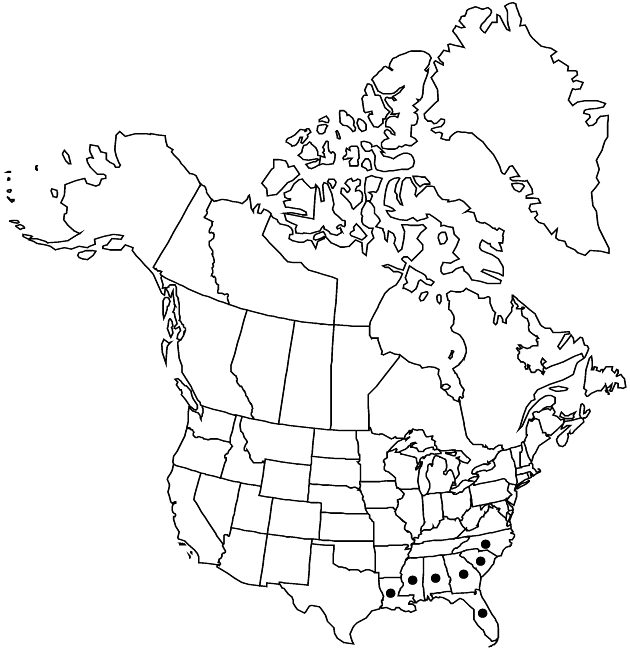Difference between revisions of "Carphephorus odoratissimus"
Rhodora 70: 483. 1968.
Common names: Vanillaleaf
Endemic
Basionym: Chrysocoma odoratissima J. F. Gmelin Syst. Nat. 2: 1204. 1792
Synonyms: Liatris odoratissima (J. F. Gmelin) Michaux Trilisa odoratissima (J. F. Gmelin) Cassini
Treatment appears in FNA Volume 21. Treatment on page 536.
FNA>Volume Importer |
RevisionBot (talk | contribs) m (Bot: Adding category Revised Since Print) |
||
| (4 intermediate revisions by 3 users not shown) | |||
| Line 8: | Line 8: | ||
}} | }} | ||
|common_names=Vanillaleaf | |common_names=Vanillaleaf | ||
| + | |special_status={{Treatment/ID/Special_status | ||
| + | |code=E | ||
| + | |label=Endemic | ||
| + | }} | ||
|basionyms={{Treatment/ID/Basionym | |basionyms={{Treatment/ID/Basionym | ||
|name=Chrysocoma odoratissima | |name=Chrysocoma odoratissima | ||
| Line 34: | Line 38: | ||
-->{{Treatment/Body | -->{{Treatment/Body | ||
| − | |distribution= | + | |distribution=Ala.;Fla.;Ga.;La.;Miss.;N.C.;S.C. |
|discussion=<p>Varieties 2 (2 in the flora).</p> | |discussion=<p>Varieties 2 (2 in the flora).</p> | ||
|tables= | |tables= | ||
| Line 64: | Line 68: | ||
|basionyms=Chrysocoma odoratissima | |basionyms=Chrysocoma odoratissima | ||
|family=Asteraceae | |family=Asteraceae | ||
| − | |distribution= | + | |distribution=Ala.;Fla.;Ga.;La.;Miss.;N.C.;S.C. |
|reference=None | |reference=None | ||
|publication title=Rhodora | |publication title=Rhodora | ||
|publication year=1968 | |publication year=1968 | ||
| − | |special status= | + | |special status=Endemic |
| − | |source xml=https:// | + | |source xml=https://bitbucket.org/aafc-mbb/fna-data-curation/src/2e0870ddd59836b60bcf96646a41e87ea5a5943a/coarse_grained_fna_xml/V19-20-21/V21_1361.xml |
|tribe=Asteraceae tribe Eupatorieae | |tribe=Asteraceae tribe Eupatorieae | ||
|genus=Carphephorus | |genus=Carphephorus | ||
| Line 75: | Line 79: | ||
}}<!-- | }}<!-- | ||
| − | -->[[Category:Treatment]][[Category:Carphephorus]] | + | --> |
| + | |||
| + | [[Category:Treatment]] | ||
| + | [[Category:Carphephorus]] | ||
| + | [[Category:Revised Since Print]] | ||
Latest revision as of 18:23, 6 November 2020
Plants 50–140(–180) cm. Stems glabrous. Leaves: basal oblanceolate to obovate, mostly 9–50 cm; proximal cauline well developed, gradually reduced distally, clasping, faces not gland-dotted. Heads in flat-topped, corymbiform arrays. Peduncles glabrous. Involucres 3.5–5 mm. Phyllaries 5–12 in 1–2(–3) series, oblanceolate, gland-dotted, apices obtuse. Receptacles epaleate or partially paleate (paleae 1–2). Corollas glandular, lobes 0.8–1 mm. Cypselae glandular; pappus bristles in ± 1 series.
Distribution

Ala., Fla., Ga., La., Miss., N.C., S.C.
Discussion
Varieties 2 (2 in the flora).
Selected References
None.
Lower Taxa
Key
| 1 | Plants with strong odor of coumarin or vanilla; basal leaves usually more than 15 × 5 cm; midstem leaves broadly elliptic, margins often shallowly dentate, apices flared away from stems; primary head-bearing branches diverging from main axes at 10–20°; florets mostly 7–10 | Carphephorus odoratissimus var. odoratissimus |
| 1 | Plants with slight or no odor of coumarin or vanilla; basal leaves less than 15 × 4 cm; midstem leaves narrowly elliptic, margins entire, apices appressed to stems; primary head-bearing branches diverging from main axes at 30–45°; florets mostly 10–14 | Carphephorus odoratissimus var. subtropicanus |